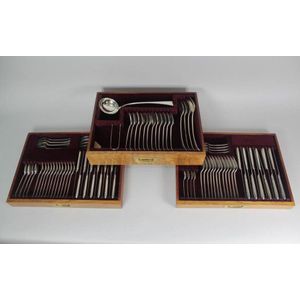Victorian Silver Cutlery Set in Oak Canteen
You must be a subscriber, and be logged in to view price and dealer details.
Subscribe Now to view actual auction price for this item
When you subscribe, you have the option of setting the currency in which to display prices to $Au, $US, $NZ or Stg.
- Canteen - A small cabinet, table or a box with drawers or lift out trays, for storing a set of cutlery.
- Sterling Silver - Sterling silver is a mixture of 92.5% pure silver and 7.5% of another metal, usually copper. Fine silver is 99.9% pure silver, and is relatively soft and the addition of the very small amount of copper gives the metal enough strength and hardness to be worked into jewellery, decorative and household objects.
- Oak - Native to Europe and England, oak has been used for joinery, furniture and building since the beginning of the medieval civilisation. It is a pale yellow in colour when freshly cut and darkens with age to a mid brown colour.
Oak as a furniture timber was superceded by walnut in the 17th century, and in the 18th century by mahogany,
Semi-fossilised bog oak is black in colour, and is found in peat bogs where the trees have fallen and been preserved from decay by the bog. It is used for jewellery and small carved trinkets.
Pollard oak is taken from an oak that has been regularly pollarded, that is the upper branches have been removed at the top of the trunk, result that new branches would appear, and over time the top would become ball-like. . When harvested and sawn, the timber displays a continuous surface of knotty circles. The timber was scarce and expensive and was used in more expensive pieces of furniture in the Regency and Victorian periods. - Victorian Period - The Victorian period of furniture and decorative arts design covers the reign of Queen Victoria from 1837 to 1901. There was not one dominant style of furniture in the Victorian period. Designers used and modified many historical styles such as Gothic, Tudor, Elizabethan, English Rococo, Neoclassical and others, although use of some styles, such as English Rococo and Gothic tended to dominate the furniture manufacture of the period.
The Victorian period was preceded by the Regency and William IV periods, and followed by the Edwardian period, named for Edward VII (1841 ? 1910) who was King of the United Kingdom and the British Dominions and Emperor of India for the brief period from 1901 until his death in 1910.
This item has been included into following indexes:
Visually similar items

Hallmarked silver cigarette box

A George V silver canteen of cutlery in an oak presentation case. Maker, Walker and Hall, Sheffield, 1920. Comprising: Two sauce ladles, a soup ladle, and a basting spoon, 457g Eighteen desert spoons, 909g Eighteen soup spoons 1149g Six teaspoons, 111g Fiv

An American sterling silver cutlery canteen marked Wallace, sterling, comprising 9 dinner forks and knives, 3 large spoons, 9 dessert spoons, 19 coffee spoons, 13 teaspoons, 8 cocktail forks, 8 cake forks, caving knife and fork, 6 butter knives and eight s

George III hallmarked sterling silver Old English pattern cutlery service by George Smith III and William Fearn, London 1788 - 1794, 3420 grams
